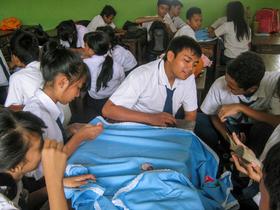For the 2025-26 school year, there is 1 public school serving 268 students in the neighborhood of Hoover Foster, Emeryville, CA.
The neighborhood of Hoover Foster, Emeryville, CA public schools have a diversity score of 0.66, which is more than the California public school average of 0.63.
Minority enrollment is 90% of the student body (majority Hispanic), which is more than the California public school average of 80% (majority Hispanic).
Best Public Schools in the neighborhood of Hoover Foster, Emeryville, CA (2025-26)
School
(Math and Reading Proficiency)
(Math and Reading Proficiency)
Location
Quick Facts
Rank: #11.
Hoover Elementary School
(Math: 6-9% | Reading: 10-14%)
Rank:
Rank:
1/
Bottom 50%10
890 Brockhurst St.
Emeryville, CA 94608
(510) 879-2170
Emeryville, CA 94608
(510) 879-2170
Gr: K-5 | 268 students Student-teacher ratio: 27:1 Minority enrollment: 91%
Frequently Asked Questions
What are the top-ranked public schools in the neighborhood of Hoover Foster, Emeryville, CA?
The top-ranked public schools in the neighborhood of Hoover Foster, Emeryville, CA include Hoover Elementary School.
How many public schools are located in the neighborhood of Hoover Foster, Emeryville?
1 public schools are located in the neighborhood of Hoover Foster, Emeryville.
What is the racial composition of students in the neighborhood of Hoover Foster, Emeryville?
the neighborhood of Hoover Foster, Emeryville public schools minority enrollment is 90% of the student body (majority Hispanic), which is more than the California public schools average of 80% (majority Hispanic).
Recent Articles

School Vouchers: Updated Pros and Cons (2025 Review)
Comprehensive 2025 analysis of school vouchers, weighing benefits and challenges for families, funding, outcomes, and policy directions.

Benefits and Drawbacks of Homework in 2025
Explore updated 2025 insights on homework鈥檚 benefits, drawbacks, mental health impact, best practices, and policy trends in U.S. public schools.

Charter Schools vs Public Schools 2025: Key Differences & Trends
Explore updated 2025 insights comparing charter schools vs public schools, enrollment, academic outcomes, funding, and real-world examples for families and educators.
